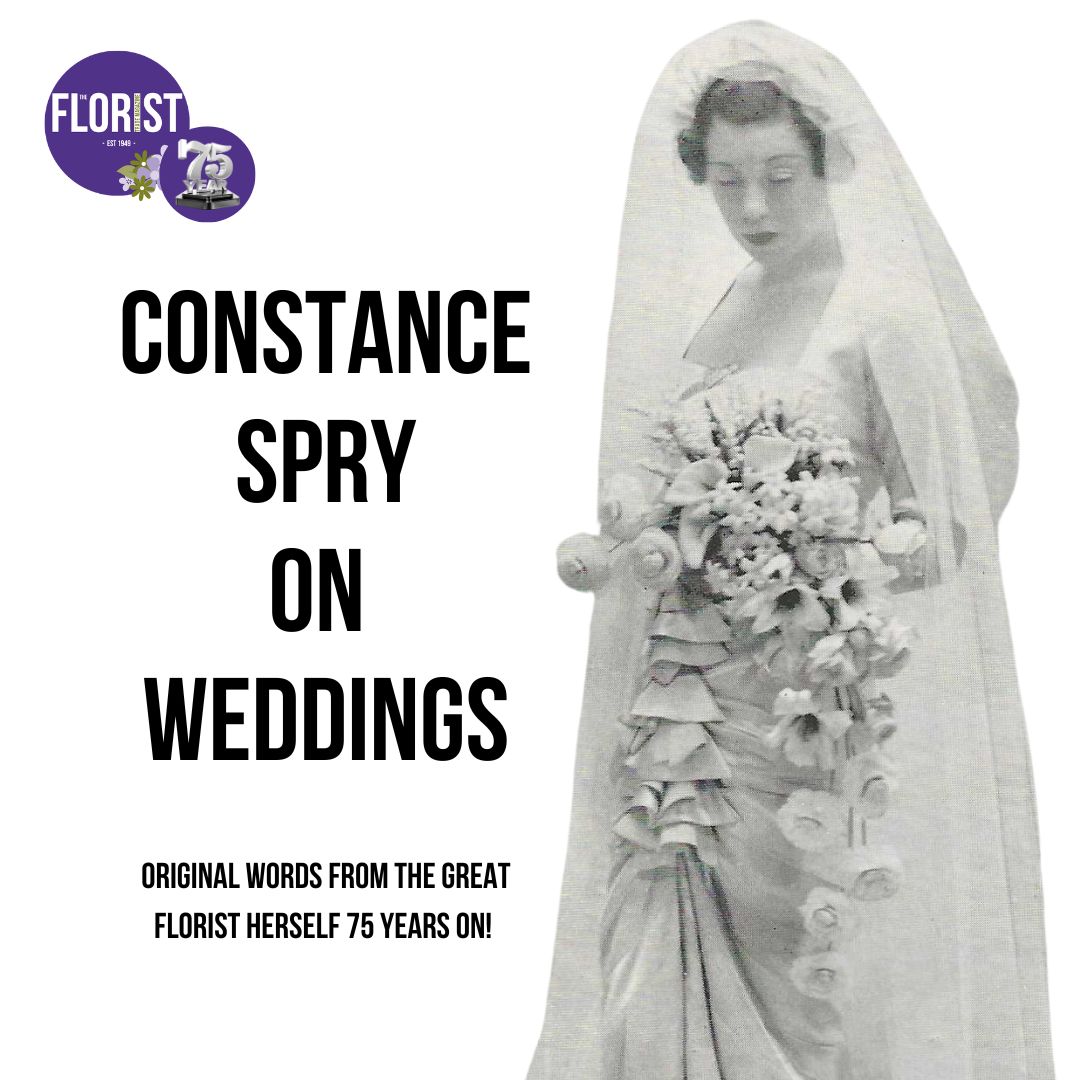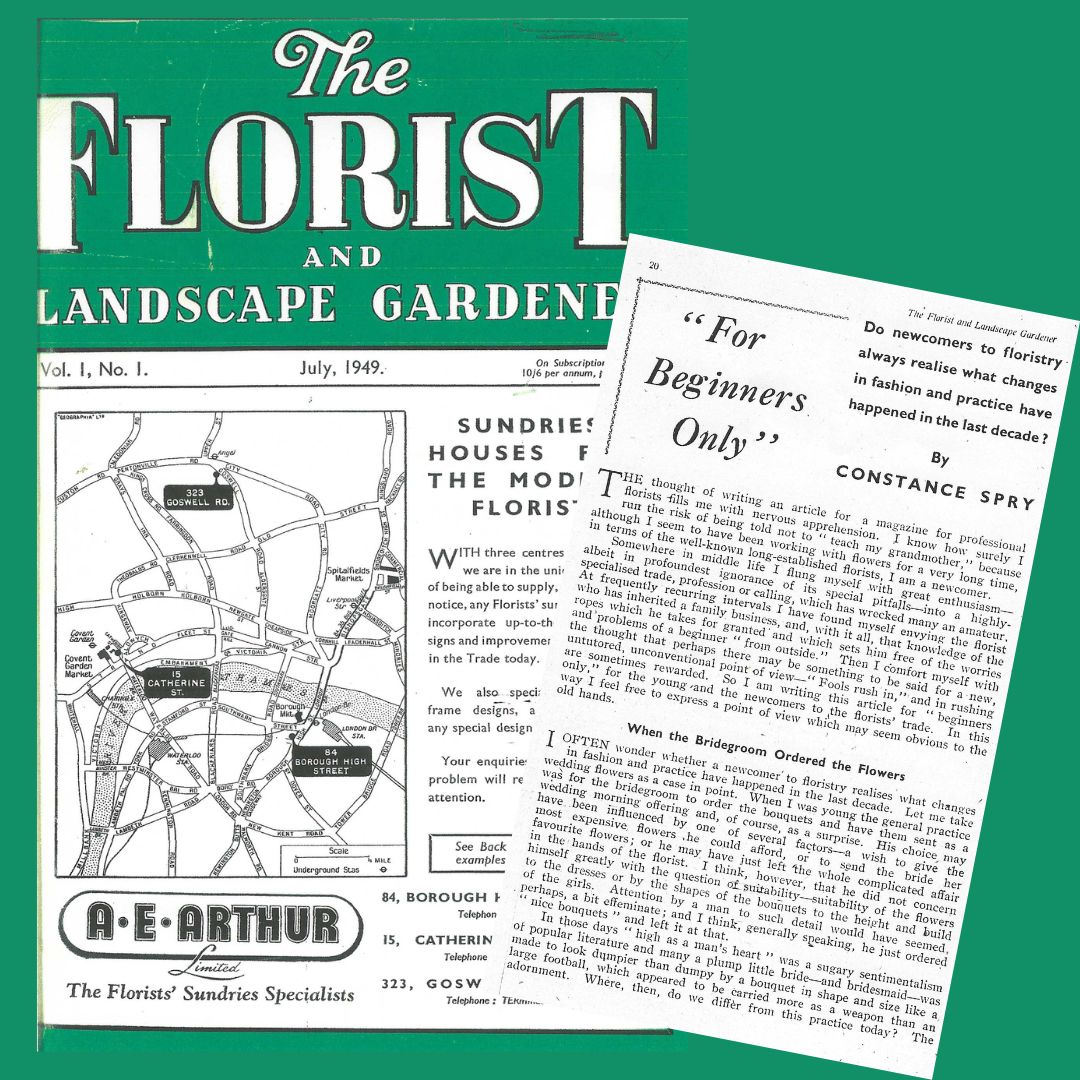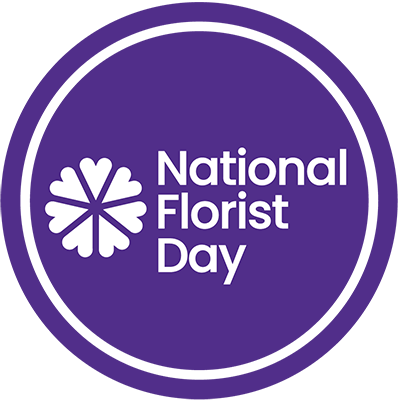
Constance Spry advice in her original words.
Back in July 1949 the very first edition of Florist & Landscape Gardener appeared with an article from the great Constance Spry … who, rather spookily, had just trained and was employing our second Editor, Jayne Foster, mother of our current Editor!
As we begin our trawl back into 75 years of archives, we publish Constance’s very first article in full along with the pictures that accompanied the text … with only black and white printing allowed (this was post war Britain and money was tight) you had to read every word and a vivid imagination was required!
For beginners only
Do newcomers to floristry always realise what changes in fashion and practice have happened in the last decade?
Words and pictures Constance Spry July 1949
Copyright Purple Spotted Media
The thought of writing an article for a magazine for professional florists fills me with nervous apprehension.
I know how surely I run the risk of being told not to ‘teach my grandmother’ because, although I seem to have been working with flowers for a very long time, in terms of the well-known, long established florists I am a newcomer.
Somewhere in middle life I flung myself with great enthusiasm - albeit in profoundest ignorance of its special pitfalls - into a highly specialised trade, profession or calling which has wrecked many an amateur.
At frequently recurring intervals I have found myself envying the florist who has inherited a family business, and, with it all, that knowledge of the ropes which he takes for granted and which sets him free from the worries and problems of a beginner ‘from outside’.
Then I comfort myself with the thought that perhaps there may be something to be said for a new untutored, unconventional point of view – “Fools rush in” and in rushing are sometimes rewarded.
So, I am writing this article for “beginners only”, for the young and the newcomers to the florist trade. In this way I feel to express a point of view which may seem obvious to the old hands
When the bridegroom ordered the flowers
I often wonder whether a newcomer to floristry realises what changes in fashion and practise have happened in the last decade. Let me take wedding flowers as a case in point. When I was young the general practise was for the bridegroom to order the bouquets and have them sent as a wedding morning offering and, of course, as a surprise.
His choice may have been influenced by one of several factors. A wish to give the most expensive flowers he could afford or to send the bride her favourite flowers or he may have just left the whole complicated affair in the hands of the florist.
I think however, that he did not concern himself greatly with the question of suitability. Suitability of the flowers to the dresses or by the shape of the bouquets to the height and build of the girls. Attention by a man in such detail would have seemed perhaps a bit effeminate; and I think, generally speaking, he just ordered “nice bouquets” and left it at that.
In those days “high as a man’s heart” was a sugary sentimentalism of popular literature and many a plump little bride - and bridesmaid - was made to look dumpier than dumpy by a bouquet in shape and size like a large football, which appeared to be carried more as a weapon than an adornment. Where, then, do we differ from this practise today?
The bridegroom still usually pays for the flowers, but more often than not it is the bride or her mother who makes the choice and, if they have taste and discernment, they do so with an eye to the suitability of flowers to clothes, and with some thought of the height of the girls who are to carry them
A florist who thinks on these lines will, given reasonable opportunity, soon gain a reputation for taste and sense. The question of suitability sometimes involves much work and trouble without necessarily a commensurate financial return. It needs a clear integrity of purpose to disregard considerations of money or of convenience and to suggest, maybe, simple and inexpensive flowers when some young and dewy girl is wondering “if orchids wouldn’t be lovely”.
But on the purest commercial basis it is common sense.
The fashion for wedding bouquets is discredited whenever an unsuitable bouquet is carried - unsuitable by reason of shape, flowers, colour or because it detracts from the dress. A proper regard for the work of the dress designer or maker should be a matter of first consideration and an artistic florist will see to it that the flowers harmoniously strengthen and support the whole.
This will seem commonplace to those who work with the florist who has earned the reputation for good taste, but I think it is not to everyone - not if one is to believe the evidence of photography.
A useful way of getting one’s eye in is to study the wedding photographs and magazines and newspapers, observing where restraint has made for good line and elegance and where too much fern and fuzz and heaviness have spoiled things.
Far-seeing owners of flower shops will seek opportunity for their employees to see collections of clothes and to have opportunity for forming their tastes. We are none of us such slaves to convention as we once were, and this freedom gives great scope in the planning of bouquets. Let me give some examples that immediately come to mind.
Bouquets must be aesthetically right.
One bride recently had a dress of gold and white brocade made from a length of exquisite material inherited in a bridal chest from an earlier generation - such fabric as you and I dream about. It really did “stand by itself”. The design was as beautiful as the material and called for a bouquet of dignity and restraint. After a lot of thought we decided that Magnolia flowers would be right and not too many of them. A bouquet on the lines of the picture on page 24 was made and although this may not have what might be called popular appeal, it looked so right with the dress in question that it was greatly admired and praised and incidentally brought in orders.

The making of such a bouquet involves the florist in far more trouble than would the conventional one of, say, Carnations or Roses and trouble of a kind which cannot perhaps properly be charged for. Nevertheless, it is more than worthwhile to produce something which is aesthetically right.
Lately a bride wearing a tulle dress carried a bouquet of Hyacinth bells - what florists call ‘pipped’ Hyacinths. It really was a delicate cascade of tiny bells. Her maids had hand sprays of blue hyacinths and wine-coloured freesia like the picture on page 21.

I remember a bride coming to see me and explaining that she was being married in a small, beautiful city church which was to be lighted only with candles. She was wearing a dress of gold brocade and wanted her flowers to look like stars laid on her dress, so they were mounted on fine gold bound stems which being invisible against the gold dress gave the effect she had imagined.
In either of these cases a conventional bouquet might so easily have been irrelevant and have spoiled the beauty of the dress.
The picture on page 23 shows a bouquet of shell pink rhododendrons which was carried by a bride wearing an old lace veil over an ivory satin dress. White flowers or green fern would have detracted from the beauty of the lace, the soft pink brought it into relief.

Now a word about the rest of the wedding flowers and first of these are headdresses. Whatever shape and flowers may be chosen, it is important to modify each headdress to suit the individual who is to wear it.
I have heard it argued that if every headdress is made exactly alike, the general effect will be uniform, but this is not so, for the general effect is modified by individual hairstyle. A clever florist will make very small adjustments so that while the general effect is of one of uniformity, each individual head and face has been considered and suited
Fashion and flowers for the mothers of bride and bridegroom has somewhat changed too. In the past these ladies often carried bouquets. More often now they elect a wear flowers. Here is scope for the florist to use originality if she is not compelled to follow convention.
A corsage of flowers and leaves of such colourings that they seem to have been created expressly to go with the dress in question, will give more pleasure and look more beautiful than a conventional spray of, perhaps, roses and fern or carnations or orchid. Each of these flowers is beautiful and each can be most beautifully employed but to do so needs thought.
A corsage of three carnations and fern with a bit of silver paper showing on the stems is not really elegant though a ‘Malmaison’**, beautifully made from the same number of carnations backed with a little of their own foliage can be extremely smart.
A spray of three roses upside down, pinned on the shoulder does not always enhance the general effect and often detracts from a smart frock; but a ‘cabbage’ ** rose, made from the petals of full-blown roses is enchanting - more trouble - oh yes, much more but much more exciting and much more likely to earn a reputation for taste
And orchids - so beautiful, so elegant and so often misapplied, their strange essential quality dowsed by smother of fern, “finished off” with silver paper and even a bow of ribbon. This treatment of them has begun to detract from their once immense popularity and one may even hear the word “vulgar” whispered in connection with these magnificent flowers.
I think this is to some extent the fault of the florist. To my mind the strange quality of an orchid wants judicious treatment and judicious wearing - for it is by no means suitable for every dress and every occasion. For instance, certain varieties seem to call for the use of formal tropical leaves, rather than for fern, in make-up, and none of them seems to me suitable for any and every dress and occasion.
If from indifference, or for gain, these flowers are pushed in season and out of season they will lose popularity; for when used unsuitably or ostentatiously they certainly come in for adverse criticism and this is no fate for such a wonderful flower
Perhaps the whole burden of my song to the young florist is this; flowers are exquisite things but injudiciously used they can look wrong - even ugly. So, keep a critical eye on all you do; be judicious, selective, impersonal (don’t have favourite flowers) and ally your art to the other arts.
Be your own hardest critic, and remember you are a creative artist and nothing ugly, clumsy or out of place must escape you if you can possibly help it.
Editors note: ** Malmaison is a term referring to the creation of a design using the parts of a flower – in this case carnations. You take the whole flower out of the Calyx and layer each petal to create a bigger, fluffier ‘flower’ Can also be called a Glamellia (made using gladioli petals to create a giant camellia look – much favoured in the 50’s) or a Carmen Rose … a central rose surrounded by layer upon layer of rose petals. The generic term is Composite, they are incredibly time consuming so expensive but rather decadent and worthy we think of making a comeback along with showers, cascades and anything else that uses real technical skill!







